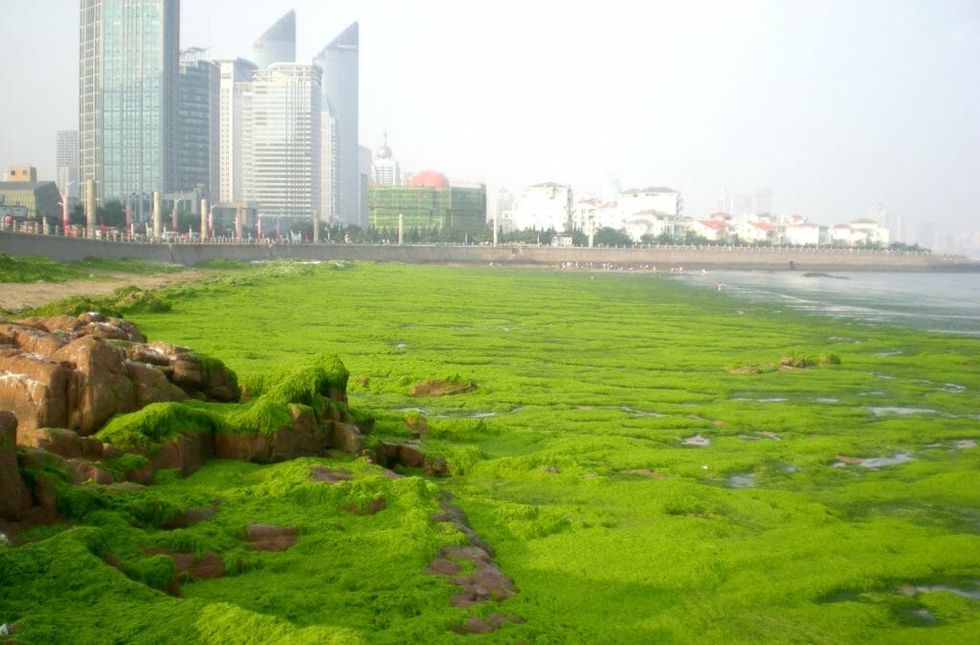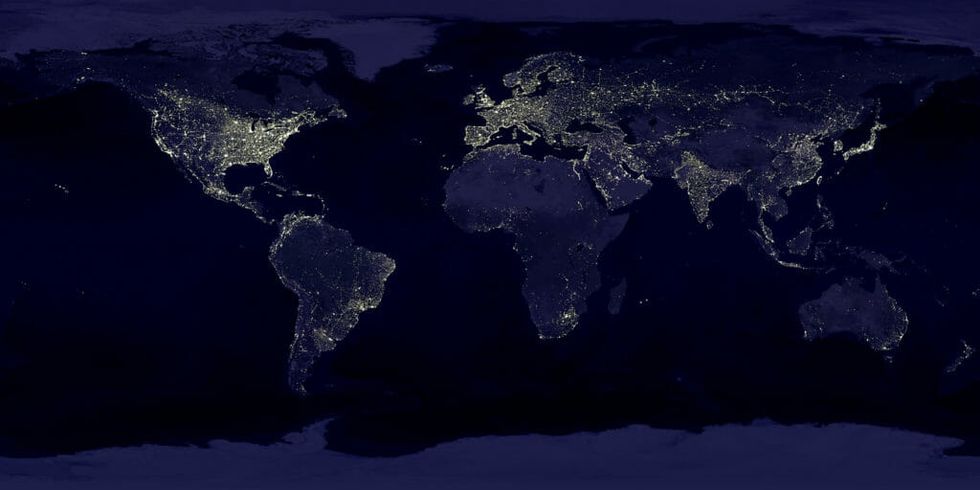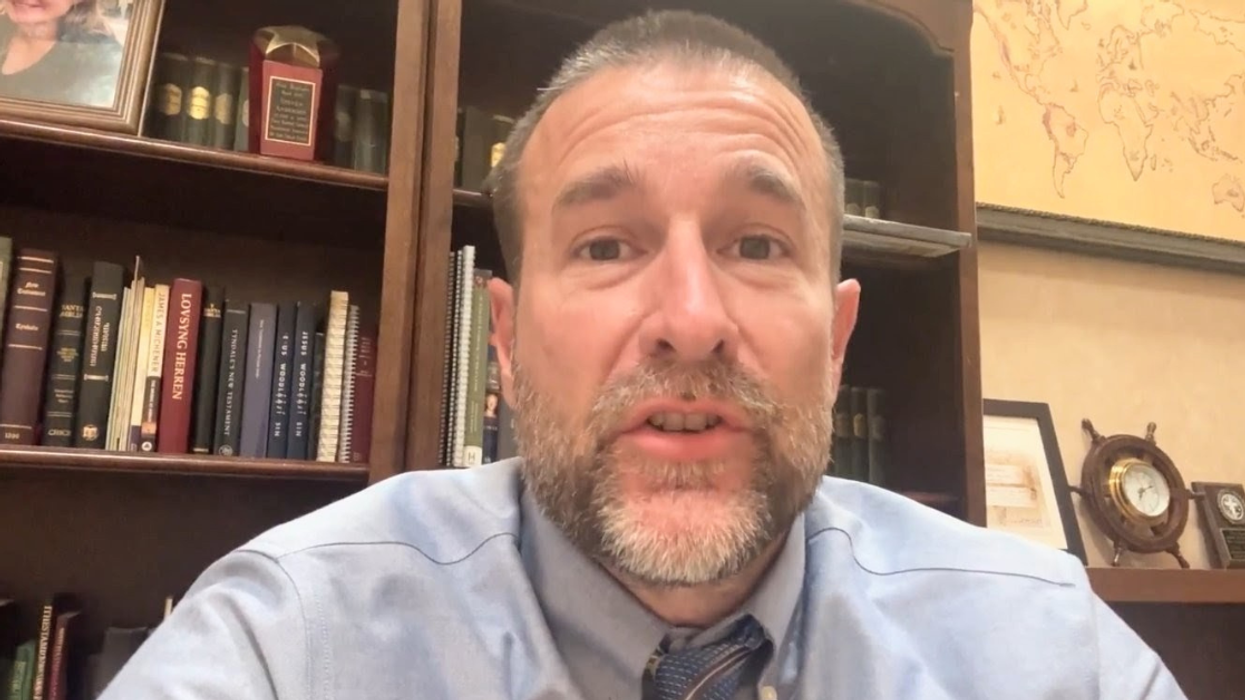Carbon pollution is not the only man-made problem for Earth's oceans. Coastal pollution from runoff, often containing fertilizers, pesticides and other waste products (sewage) are also hastening the collapse of Earth’s oceanic oxygen cycle. Oxygen-free “dead zones” in Earth’s oceans are appearing and expanding at an alarming rate. Disruptions in the oceans’ oxygen cycle are the single-most significant and direct consequence of global industrialization.
Humans and most other land and marine animals breathe oxygen, and complex life as we know it cannot survive without it. It look more than four billion years for oceanic photosynthesis to release sufficient quantities of oxygen for terrestrial life to evolve. Life on Earth depends upon a delicate balance between the atmosphere and oceans. Ocean water absorbs most of the heat Earth receives from the Sun, and the relationship between ocean currents and atmospheric chemistry shapes the global climate.
Prior to the Industrial Revolution of the 18th and 19th centuries, global oxygen levels had remained relatively stable for millions of years. As atmospheric carbon dioxide concentrations increase due to the burning of fossil fuels, excess heat from the Sun gets trapped, which in turn raises average ocean temperatures.
Because of its naturally volatile state, atomic oxygen doesn’t accumulate on Earth in large quantities; oxygen supplies in the ocean and atmosphere continuously regenerate so that fish, mammals and terrestrial life can flourish. In fact, 50-85 percent of Earth’s oxygen is generated by phytoplankton, tiny algae that release oxygen through photosynthesis.

As temperatures in Earth’s oceans rise, natural processes like photosynthesis that release oxygen into the water cannot keep up with demand. Warm water does not hold onto atomic oxygen. Individual oxygen atoms are unstable (making it highly combustible, hence its use as rocket fuel) and bond with other oxygen atoms to form O2, which comprises 20 percent of Earth’s atmosphere. Molecules of O2 also bond with oxygen atoms to form O3 (ozone), the thin atmospheric layer that blocks ultraviolet light from the Sun. Furthermore, oxygen atoms bond with other elements, like carbon, to form compounds like carbon dioxide, leading to a feedback loop of more surface heating.
Climate change was also determined to be the cause of “the blob;” an enormous heatwave in 2016 that affected a quarter of the world’s oceans. Excess ocean heat decimated ecosystems throughout the oceans and led to the death of countless marine organisms. In a study in the Bulletin of the American Meteorological Society, lead researcher Dr. Eric Oliver and his team analyzed the effects “the blob” had on the seas off Australia’s northern coast, as well as the northern Pacific Ocean between Russia and Alaska. Heatwaves, like the blob in 2016, are responsible for killing thousands of marine animals, including birds and whales. Increases in oceanic heat also lead to the bleaching of coral reefs, such as the Great Barrier Reef in Australia.
“Scientists are inherently conservative about making grand claims, but we can say with 99 percent confidence that anthropogenic climate change made this marine heatwave several times more likely, and there’s an increasing probability of such extreme events in the future,” Dr. Oliver concluded. The series of heatwaves comprising the blob were the longest lasting and most intense ever recorded.
Climate change and pollution are literally choking Earth’s oceans.
Researchers at Arizona State University published the largest ever study of dead zones and coastal hypoxia in the journal Science Advances. Scientists hoped to understand how dead zones occur from natural processes. Around 94 million years ago, Earth experienced an “Oceanic Anoxic Event” (named OAE-2) in which oxygen levels in the oceans decreased, driven by “various combinations of increased surface temperatures (2), sea level rise (3), nutrient trapping (4), and pulses of magmatic activity,” study leader Chandlin M. Ostrander explains. The 50,000-year-long event led to a major extinction, wiping out 27 percent of marine invertebrates.
While Cretaceous Era OAE-2 was the result of an uptick in global volcanic activity, the study concludes that “increased ocean deoxygenation is already apparent in the modern ocean, because marine O2 has decreased by 2% over roughly the last half century (41), and recent models predict a continued loss of 0.5 to 3.5% over the next half century (1, 42), which would result in huge expansions of ocean anoxia within the next few thousand years.” While these processes (minus human pollution) do happen naturally,, industrialized society is responsible for the rate at which oceanic oxygen is dropping.
Simply put, human activity is causing another Oceanic Anoxic Event.
Further evidence of humanity’s detrimental effect on Earth’s oceans can be found in a second Science study published in January 2018. “In the open ocean, global warming, which is primarily caused by increased greenhouse gas emissions, is considered the primary cause of ongoing deoxygenation,” explains lead researcher Denise Breitburg. “Expansion of low-oxygen zones can increase production of N2O, a potent greenhouse gas; reduce eukaryotic biodiversity; alter the structure of food webs; and negatively affect food security and livelihoods.” Nitrous oxide (N2O) is a powerful greenhouse gas produced in low-oxygen zones. Although it has a shorter half-life than carbon dioxide, its heat-trapping ability is hundreds of times stronger.
Hypoxic zones, which are being found off every inhabited coastal region on Earth, are driven by toxic, chemical-laden runoff. Coastal human habitation is the only cause of coastal hypoxia.
Since 1950, oxygen-empty oceanic “dead zones” have quadrupled and coastal regions of perilously low oxygen levels have multiplied by a factor of ten (there are at least 500 known), according to a UNESCO-led analysis of Breitburg’s study. Unfortunately, these areas are only what have been observed thus far. There could be many more coastal hypoxia zones where monitoring efforts are either non-existent or still in their infancy.
The largest dead zone is in the Gulf of Mexico, covering in excess of 10,000 square kilometers. Prof Robert Diaz at the Virginia Institute of Marine Science, who reviewed the new study, offered a sobering claim: "no other variable of such ecological importance to coastal ecosystems has changed so drastically in such a short period of time from human activities as dissolved oxygen.”
Dead zones in the open ocean now encompass 4.5 million square kilometers, equivalent to the area of 46 percent of the continental United States.
“This is mainly the result of human activities that are increasing global temperatures (CO2-induced warming) and increasing loads of nutrients from agriculture, sewage, and industrial waste, including pollution from power generation from fossil fuels and biomass,” states the Global Ocean Oxygen Network (GO2NE), the faction of UNESCO that performed the analysis. GO2NE is “committed to providing a global and multidisciplinary view of deoxygenation, with a focus on understanding its multiple aspects and impacts.”
Phytoplankton rapidly multiply in nutrient-rich environments, which pollutants containing nitrates and phosphates provide. Initially, a dense colony of algae releases some oxgyen, but the boon is short-lived. Swarms of surface algae prevent sunlight from reaching underwater plant life, killing it and its essential production of oxygen. When large, concentrated populations of phytoplankton run out of food and die en masse, they sink to the ocean floor where they are broken down by microbes and other organisms. These microscopic scavengers also consume substantial amounts of oxygen, furthering overall oceanic depletion. Once all the remaining oxygen is used up, hypoxic zones become dead zones.

In its analysis, GO2NE identifies ten alarming trends in declining oxygen levels in Earth’s oceans:
“Increasing temperatures will reduce the capacity of the ocean to hold oxygen in the future;
- Oxygen deficiency is predicted to worsen in estuaries, coastal areas and oxygen minimum zones in the open ocean;
- The ocean’s capacity to produce oxygen will be reduced in the future.
- Habitat loss is expected to worsen, leading to vertical and horizontal migration of species;
- Oxygen deficiency will alter biogeochemical cycles and food webs;
- Lower oxygen concentrations are projected to result in a decrease in reproductive capacity and biodiversity loss;
- There are important local decreases of commercially important species and aquaculture production;
- Harmful Algal Blooms might benefit from nutrients released in bottom waters due to hypoxia (e.g. in the Baltic Sea);
- Reduced ocean oxygen concentrations will lead to an increase in greenhouse gas emissions, thereby initiating feedbacks on climate change;
- Future scenarios for oxygen depend on a combination of drivers related to global environmental change and land-use, including warming, growing human population, and extensive coastal agricultural practices, which, in turn, act together in affecting marine ecosystems – thus, a multi-stressor approach is important."

The most important takeaway from the studies and subsequent analyses, however, is that the current Oceanic Anoxic Event is entirely preventable and completely reversible. By reducing and eliminating pollution-containing toxic runoff and carbon emissions, Earth’s oceans can recover, and global disaster can be avoided. But humans are stubborn creatures, and the longer we kick the proverbial can down the road, the higher the price future generations will pay for our willful and selfish inaction.
What consequences will civilization face if oxygen concentrations keep declining?

In the image above, take note of how densely populated coastlines align perfectly with coastal hypoxic zones. More than 2.4 billion people, or a third of the human race, live within 100 kilometers of an oceanic coast. Future coastal dead zones will be devoid of fish, which feed 500 million people and whose industry employs 350 million people around the world. Citizens of poorer countries will be the first to experience massive food shortages. To compensate, fishing rates will increase in healthier waters, but this will only exacerbate global over-fishing. Overgrowth of algae in dead zones can also contaminate drinking water, leading to illness in people and fauna.
The same forces upsetting the balance of oxygen shifts in the oceans will affect various natural cycles that regulate Earth's climate. Warm oceans are the primary supply of energy for hurricanes and typhoons; coastal cities can expect inundation from ever-more powerful storm surges churned up by more intense tropical cyclones. In 2017, three mammoth hurricanes respectively slammed into Texas, Florida and Puerto Rico, killing over 1,000 people and causing over $300 billion in damage. Hurricane Harvey, which drowned much of Houston, Texas, in September 2017, was the most expensive natural disaster in US history with a price tag of between $125 and $200 billion.
Humanity caused this, and humanity can fix it. The question is, will we?












 Happy Feeling Myself GIF by Laff
Happy Feeling Myself GIF by Laff  Charlie Day Ok GIF
Charlie Day Ok GIF  Happy Sesame Street GIF by Muppet Wiki
Happy Sesame Street GIF by Muppet Wiki 
 @max_balegde/TikTok
@max_balegde/TikTok @max_balegde/TikTok
@max_balegde/TikTok @max_balegde/TikTok
@max_balegde/TikTok @max_balegde/TikTok
@max_balegde/TikTok @max_balegde/TikTok
@max_balegde/TikTok @max_balegde/TikTok
@max_balegde/TikTok @max_balegde/TikTok
@max_balegde/TikTok @max_balegde/TikTok
@max_balegde/TikTok @max_balegde/TikTok
@max_balegde/TikTok @max_balegde/TikTok
@max_balegde/TikTok
 @jackuno/Instagram
@jackuno/Instagram @jackuno/Instagram
@jackuno/Instagram @jackuno/Instagram
@jackuno/Instagram @jackuno/Instagram
@jackuno/Instagram @jackuno/Instagram
@jackuno/Instagram @jackuno/Instagram
@jackuno/Instagram @jackuno/Instagram
@jackuno/Instagram @jackuno/Instagram
@jackuno/Instagram